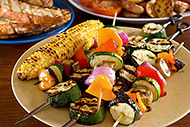
Navigating the many health recommendations and diet suggestions we see daily can be challenging. If you are having trouble deciding which foods to eat, how much to eat, and when to eat them, here are a few tips for finding your own healthy eating style.
Three Meals vs. Six Meals
Recommendations seem to vary from day to day and from expert to expert, which will likely leave you frustrated. Some say eating six small meals daily will boost metabolism, control blood sugar and hunger, and promote weight loss. Others argue that consuming only three meals and eliminating snacks will help control the blood sugar fluctuations that cause hunger and encourage the body to burn fat stores. The truth is that there is no strong scientific evidence to support either eating style, and many studies return neutral results when it comes to analyzing the magic number of meals to eat per day.
Most nutritionists agree that what you eat and how much you eat are more important. Eat only when you are truly hungry, and choose nutrient-rich foods. Everyone is different, so experiment with meal size and frequency until you find a combination that best fits your lifestyle, helps you maintain a healthy weight, and provides the energy you need to feel your best.
Value Your Choices
Making consistent healthy food choices requires valuing nutrition and your health. Everyone has different values when it comes to eating, and it’s important to select healthy foods that align with your core beliefs, including financial and cultural considerations. Creating an extensive list of rules about what you can and cannot eat can lead to an unhealthy relationship with food, making weight management more challenging. Instead, focus on what is important to you and make healthy choices that cater to your needs. Remember, there are many ways to maintain a healthy diet.
Food Intolerances
Food intolerances can significantly affect dietary intake, but they can be difficult to identify and understand. Some of the most common food intolerances include lactose (the sugar found in dairy), sulfites (found in alcoholic beverages and an additive in processed foods), and gluten (a protein in wheat, rye, and barley).
First, talk with your doctor if you suspect you have a food intolerance. After following the advice of a health professional, if you still experience problems, experiment with reducing or eliminating suspected trigger foods from your diet. Just be sure to replace any nutrients you may lose with other foods that contain them. For example, if dairy is a significant source of calcium for you, be sure to replace it with other calcium-rich foods.



 3 Healthy Lunches for Your Work Week
3 Healthy Lunches for Your Work Week
 5 Tips for Stretching Your Budget for Healthy Food
5 Tips for Stretching Your Budget for Healthy Food
 Best Ways to Reduce Added Sugar
Best Ways to Reduce Added Sugar
 Healthy Tips to Lighten Up Picnic Foods
Healthy Tips to Lighten Up Picnic Foods
 Do You Need to Drink Milk?
Do You Need to Drink Milk?
 Tips to Keep Track of Water Intake
Tips to Keep Track of Water Intake
 Butter vs. Margarine: What’s the Best Choice?
Butter vs. Margarine: What’s the Best Choice?
 7 Good Mood Foods
7 Good Mood Foods

 Pinterest
Pinterest RSS Feed
RSS Feed